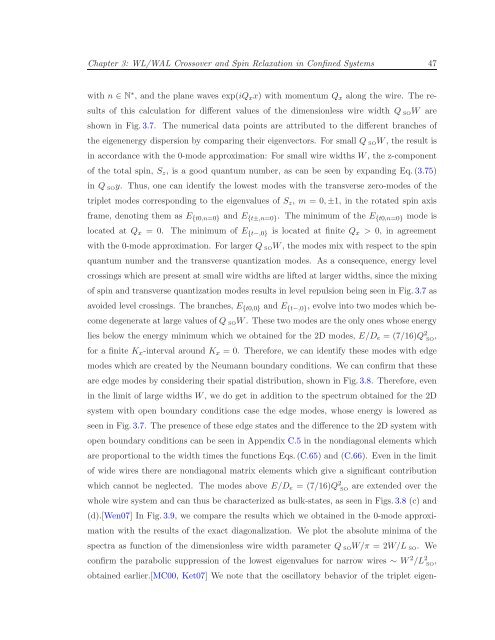Itinerant Spin Dynamics in Structures of ... - Jacobs University
Itinerant Spin Dynamics in Structures of ... - Jacobs University
Itinerant Spin Dynamics in Structures of ... - Jacobs University
You also want an ePaper? Increase the reach of your titles
YUMPU automatically turns print PDFs into web optimized ePapers that Google loves.
Chapter 3: WL/WAL Crossover and <strong>Sp<strong>in</strong></strong> Relaxation <strong>in</strong> Conf<strong>in</strong>ed Systems 47<br />
with n ∈ N ∗ , and the plane waves exp(iQ x x) with momentum Q x along the wire. The results<br />
<strong>of</strong> this calculation for different values <strong>of</strong> the dimensionless wire width Q SO W are<br />
shown <strong>in</strong> Fig.3.7. The numerical data po<strong>in</strong>ts are attributed to the different branches <strong>of</strong><br />
the eigenenergy dispersion by compar<strong>in</strong>g their eigenvectors. For small Q SO W, the result is<br />
<strong>in</strong> accordance with the 0-mode approximation: For small wire widths W, the z-component<br />
<strong>of</strong> the total sp<strong>in</strong>, S z , is a good quantum number, as can be seen by expand<strong>in</strong>g Eq.(3.75)<br />
<strong>in</strong> Q SO y. Thus, one can identify the lowest modes with the transverse zero-modes <strong>of</strong> the<br />
triplet modes correspond<strong>in</strong>g to the eigenvalues <strong>of</strong> S z , m = 0,±1, <strong>in</strong> the rotated sp<strong>in</strong> axis<br />
frame, denot<strong>in</strong>g them as E {t0,n=0} and E {t±,n=0} . The m<strong>in</strong>imum <strong>of</strong> the E {t0,n=0} mode is<br />
located at Q x = 0. The m<strong>in</strong>imum <strong>of</strong> E {t−,0} is located at f<strong>in</strong>ite Q x > 0, <strong>in</strong> agreement<br />
with the 0-mode approximation. For larger Q SO W, the modes mix with respect to the sp<strong>in</strong><br />
quantum number and the transverse quantization modes. As a consequence, energy level<br />
cross<strong>in</strong>gs which are present at small wire widths are lifted at larger widths, s<strong>in</strong>ce the mix<strong>in</strong>g<br />
<strong>of</strong> sp<strong>in</strong> and transverse quantization modes results <strong>in</strong> level repulsion be<strong>in</strong>g seen <strong>in</strong> Fig.3.7 as<br />
avoided level cross<strong>in</strong>gs. The branches, E {t0,0} and E {t−,0} , evolve <strong>in</strong>to two modes which become<br />
degenerate at large values <strong>of</strong> Q SO W. These two modes are the only ones whose energy<br />
lies below the energy m<strong>in</strong>imum which we obta<strong>in</strong>ed for the 2D modes, E/D e = (7/16)Q 2 , SO<br />
for a f<strong>in</strong>ite K x -<strong>in</strong>terval around K x = 0. Therefore, we can identify these modes with edge<br />
modes which are created by the Neumann boundary conditions. We can confirm that these<br />
are edge modes by consider<strong>in</strong>g their spatial distribution, shown <strong>in</strong> Fig.3.8. Therefore, even<br />
<strong>in</strong> the limit <strong>of</strong> large widths W, we do get <strong>in</strong> addition to the spectrum obta<strong>in</strong>ed for the 2D<br />
system with open boundary conditions case the edge modes, whose energy is lowered as<br />
seen <strong>in</strong> Fig.3.7. The presence <strong>of</strong> these edge states and the difference to the 2D system with<br />
open boundary conditions can be seen <strong>in</strong> Appendix C.5 <strong>in</strong> the nondiagonal elements which<br />
are proportional to the width times the functions Eqs.(C.65) and (C.66). Even <strong>in</strong> the limit<br />
<strong>of</strong> wide wires there are nondiagonal matrix elements which give a significant contribution<br />
which cannot be neglected. The modes above E/D e = (7/16)Q 2 SO<br />
are extended over the<br />
whole wire system and can thus be characterized as bulk-states, as seen <strong>in</strong> Figs.3.8 (c) and<br />
(d).[Wen07] In Fig.3.9, we compare the results which we obta<strong>in</strong>ed <strong>in</strong> the 0-mode approximation<br />
with the results <strong>of</strong> the exact diagonalization. We plot the absolute m<strong>in</strong>ima <strong>of</strong> the<br />
spectra as function <strong>of</strong> the dimensionless wire width parameter Q SO W/π = 2W/L SO . We<br />
confirm the parabolic suppression <strong>of</strong> the lowest eigenvalues for narrow wires ∼ W 2 /L 2 , SO<br />
obta<strong>in</strong>ed earlier.[MC00, Ket07] We note that the oscillatory behavior <strong>of</strong> the triplet eigen-
















